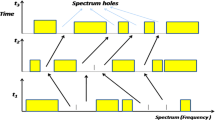Abstract
This paper aims to improve the spectrum efficiency of the licensed time division multiple access (TDMA) channel by exploiting the unused periods of primary users (PUs) in cognitive radio networks. A wireless network that consists of two classes of users, PUs and CR users, accessing a time slotted based common communication channel is considered. PUs employ TDMA and have always high priority over the CR users to access the channel. CR users utilize slotted Carrier Sense Multiple Access and can access the channel when it is not occupied by the PUs. New expressions for the throughput of both CR network and overall network have been derived in order to evaluate the channel utilization. Besides, an example network have been developed, modeled and simulated by using the OPNET Modeler simulation software with the purpose of verifying the analytical throughput results. The simulation results obtained under various network load conditions are consistent with the analytical results. This study has also proposed that the overall channel utilization can be improved by well exploiting the spectrum holes without interfering with the PU transmissions.
Similar content being viewed by others
References
Mitola J. et al (1999) Cognitive radio: Making software radios more personal. IEEE Personal Communications 6(4): 13–18
Haykin S. (2005) Cognitive radio: Brain-empowered wireless communications. IEEE Journal on Selected Areas in Communications 23(2): 201–220
Peha J. M. (2005). Approaches to spectrum sharing. IEEE Communications Magazine, Regulatory and Policy pp. 10–12
Sridhara K., Chandra A., Tripathi P. S. M. (2008) Spectrum challenges and solutions by cognitive radio: An overview. Wireless Personal Communications 45: 281–291
Zhonggui M., Hongbo W. (2012) Dynamic spectrum allocation with maximum efficiency and fairness in interactive cognitive radio network. Wireless Personal Communications 64: 439–455
Zhao Q., Sadler B. (2007) A survey of dynamic spectrum access. IEEE Signal Processing Magazine 24(3): 79–89
Budiarjo I., Lakshmanan M., Nikookar H. (2008) Cognitive radio dynamic access techniques. Wireless Personal Communications 45: 293–324
Akyildiz I. F., Lee W. Y., Vuran M. C., Mohanty S. (2006) Next generation dynamic spectrum access cognitive radio wireless networks: A survey. Computer Networks Journal 50: 2127–2159
Ciftci, S., & Torlak, M. (2012). A comparison of energy detectability models for cognitive radios in fading environments. Wireless Personal Communications. doi:10.1007/s11277-011-0468-3.
Akyildiz I. F., Lee W. Y., Chowdhury K. R. (2009) Cognitive radio ad hoc networks: Research challenges. Ad Hoc Networks Journal 7(5): 810–836
Cormio C., Chowdhury K. R. (2009) A survey on MAC Protocols for Cognitive Radio Networks. Ad Hoc Networks (Elsevier) Journal 7(7): 1315–1329
Etkin R., Parekh A., Tse D. (2007) Spectrum sharing for unlicensed bands. IEEE Journal of Selected Areas in Communications 25(3): 517–528
Liang Y. C., Zeng Y., Peh E. C. Y., Hoang A. T. (2008) Sensing throughput-tradeoff for cognitive radio networks. IEEE Transaction On Wireless Communications 7(4): 1326–1337
Lien S. Y., Tseng C. C., & Chen K. C. (2008) Carrier sensing based multiple access protocols for cognitive radio networks. Proceedings of IEEE international conference on communications (ICC), pp. 3208–3214.
Huang, S., Liu, X., & Ding, Z. (2008). Opportunistic spectrum access in cognitive radio networks. Proceedings of IEEE infocom.
Chen, Q., Liang, Y., Motani, M., Wong, W. (2009). CR-CSMA: a random access MAC protocol for cognitive radio networks. In IEEE international symposium on personal, indoor and mobile radio communications, PIMRC 2009, Tokyo, Japan, pp. 486–490.
Su, H., & Zhang, X. (2009). Secondary user friendly TDMA scheduling for primary users in cognitive radio networks. IEEE 43rd annual conference on information sciences and systems, pp. 593–599.
Thomas, R. W., DaSilva, L. A., & MacKenzie A. B. (2005). Cognitive networks. Proceedings of the IEEE DySPAN 2005, pp. 352–360.
Rom R., Sidi M. (1990) Multiple Access Protocols: performance and analysis. Springer-Verlang, New York
Li H., Grace D., Mitchell P. D. (2010) Throughput analysis of non-persistent carrier sense multiple access combined with time division multiple access and its implication for cognitive radio. IET Communications 4(11): 1356–1363
Chan W. C. (2002) Performance analysis of telecommunications and local area networks. Kluwer Academic Publishers, Dordrecht
Pahlavan K., Krishnamurthy P. (2009) Networking fundamentals, wide, local and personal area communications. Wiley, London
Yuan, J., & Torlak, M. (2011). Optimization of throughput and autonomous sensing in random access cognitive radio networks. Proceedings of the 7th IEEE International Conference on Wireless Communications and Mobile Computing, pp. 1232–1237, July 2011.
Tzeng S. S., Huang C. W. (2011) Effective throughput maximization for in-band sensing and transmission in cognitive radio networks. Wireless Networks 17(4): 1015–1029
OPNET Technologies, Inc. (2012). Optimum network simulation and engineering tool, available from http://www.opnet.co.
Author information
Authors and Affiliations
Corresponding author
Rights and permissions
About this article
Cite this article
Atmaca, S. Improving TDMA Channel Utilization in Random Access Cognitive Radio Networks by Exploiting Slotted CSMA. Wireless Pers Commun 71, 2417–2430 (2013). https://doi.org/10.1007/s11277-012-0945-3
Published:
Issue Date:
DOI: https://doi.org/10.1007/s11277-012-0945-3




